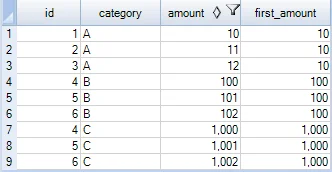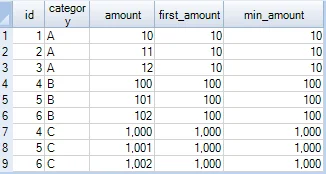As other databases, Teradata provides many aggregation functions that can be used to retrieve SUM, COUNT, MAX, MIN and AVG values. These functions returns a single value per group. To retrieve the whole first row from each 'GROUP BY' group, windowing functions can be used.
Create sample table
The following code snippet creates a sample table which will be used to query against.
create set table TestDb.test_table
(
id int not null,
category varchar(10),
amount int
)
primary index (id);
insert into TestDb.test_table values(1,'A',10);
insert into TestDb.test_table values(2,'A',11);
insert into TestDb.test_table values(3,'A',12);
insert into TestDb.test_table values(4,'B',100);
insert into TestDb.test_table values(5,'B',101);
insert into TestDb.test_table values(6,'B',102);
insert into TestDb.test_table values(4,'C',1000);
insert into TestDb.test_table values(5,'C',1001);
insert into TestDb.test_table values(6,'C',1002);
The content of the table looks like the following:
| id | category | amount |
|---|---|---|
| 1 | A | 10 |
| 2 | A | 11 |
| 3 | A | 12 |
| 4 | B | 100 |
| 4 | C | 1,000 |
| 5 | B | 101 |
| 5 | C | 1,001 |
| 6 | B | 102 |
| 6 | C | 1,002 |
Use FIRST\_VALUE function
FISRT_VALUE returns the first value of an ordered set of values.
Query:
select id, category, amount,
first_value(amount) over (partition by category order by id) as first_amount
from TestDb.test_table;
Result:

Window aggregation function
Windows aggregation function MIN can be used to retrieve the minimum value of a window group.
Query:
select id, category, amount,
first_value(amount) over (partition by category order by id) as first_amount,
min(amount) over (partition by category) as min_amount
from TestDb.test_table;
Result:

Retrieve first row in each group
ROW_NUMBER function returns sequential numbers for each row in the window partition and then QUALIFY can be used to eliminate records.
Query:
select id, category, amount
from TestDb.test_table
qualify row_number() over (partition by category order by id) = 1
;
Result:

The sample SQL statement returns returns the first row for each category value.